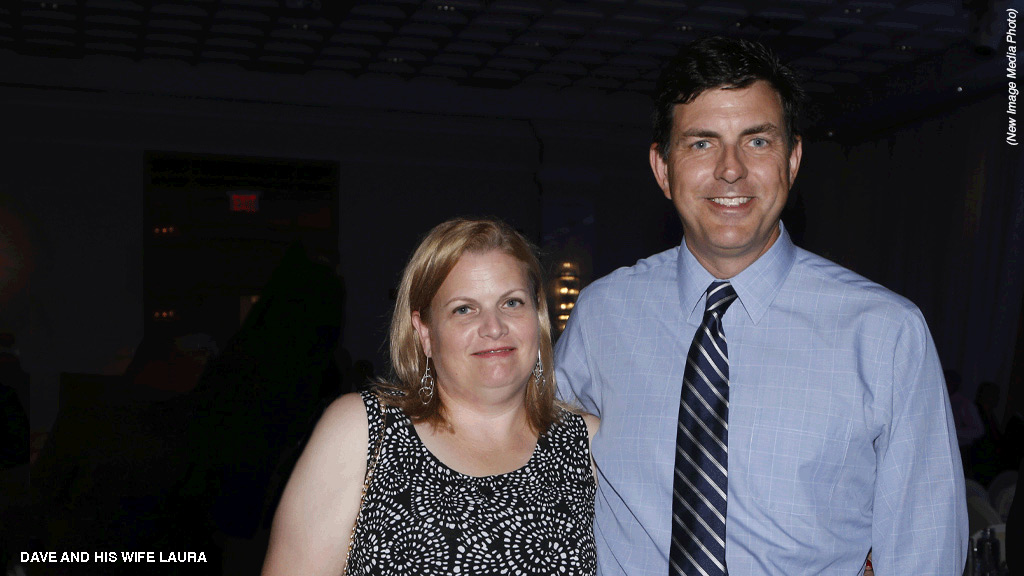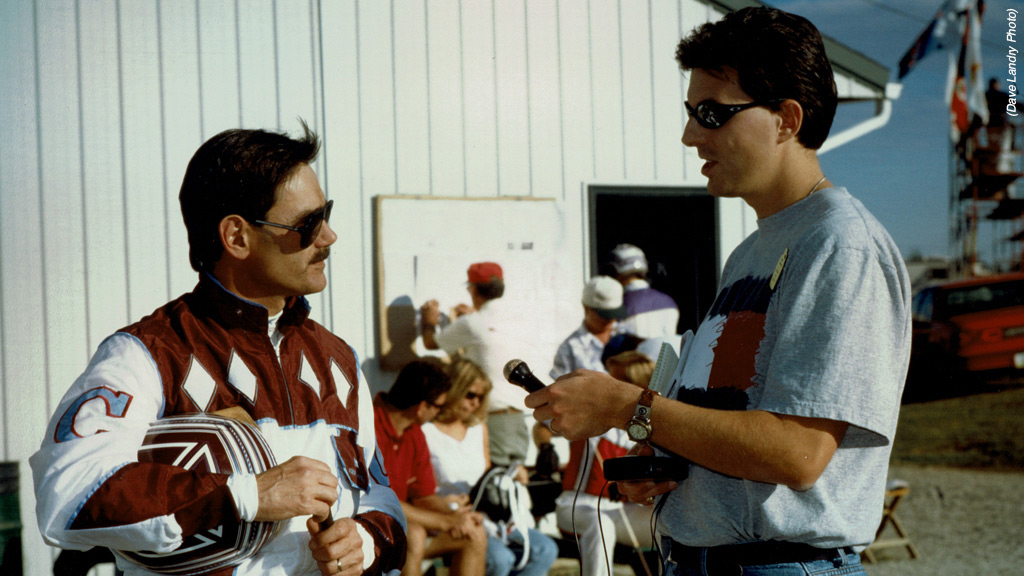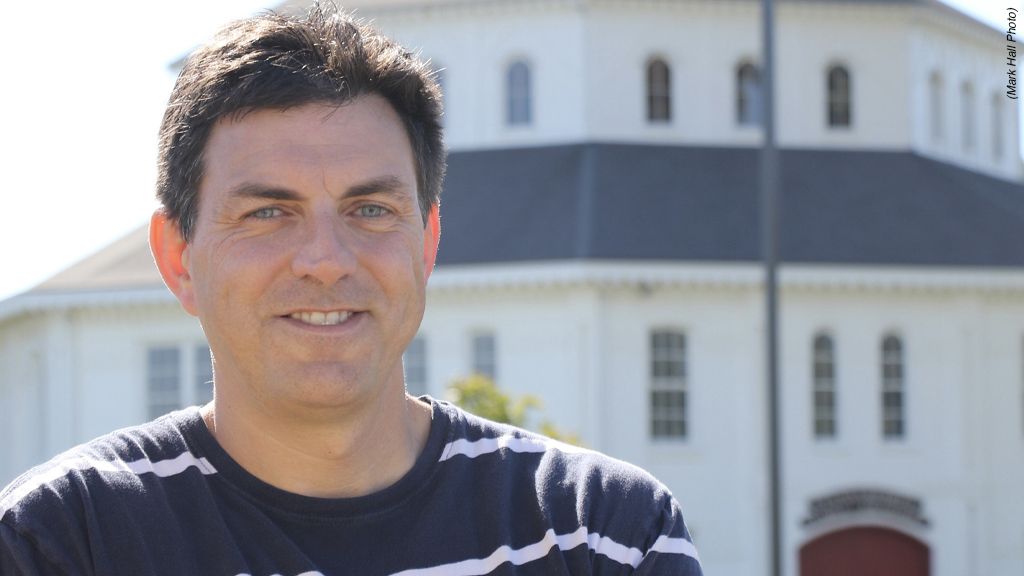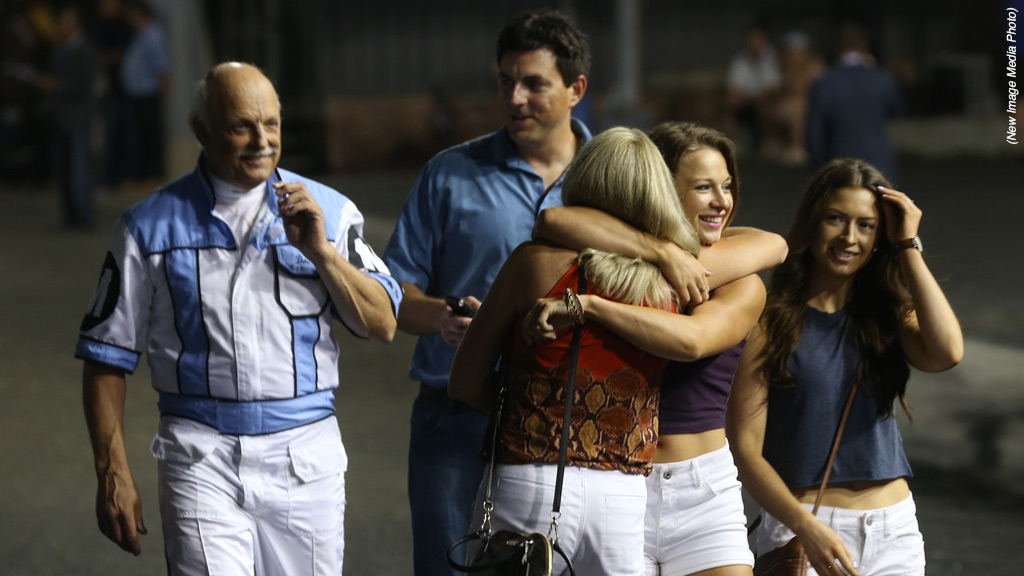Dave Briggs: He Knows Plenty About Horses Now

When Dave Briggs finished his Masters in Journalism at The University of Western Ontario, the only experience he had around horses was a one-time assignment that took place on a cold winter night at Western Fair. After landing a job at The Canadian Sportsman however, his journey into the sport he would come to love began, and now, some 12 Hervey Awards and four SC Media Excellence Awards later, the man who originally only attended Windsor Raceway for the fireworks shows, is rightfully taking his place in the CHRHF. By Rob Longley.

To say Dave Briggs didn’t know the difference between a mane and a tail when he first started writing about Standardbred racing would be an exaggeration. But before embarking on an award-winning career chronicling the stories in the sport and industry that would become his labour of love, his knowledge of the game was as green as an unraced two-year-old.
And Briggs, an inductee into the 2025 class of the Canadian Horse Racing Hall of Fame, would be the first to admit it.
“Didn’t know of it. Never heard of it,” Briggs said of the Canadian Sportsman, the magazine where his life in racing and writing would begin back in 1995. “I wasn’t a horse racing guy. I grew up down the road from Windsor Raceway but only went there for the fireworks, not to watch the races.”
Briggs can laugh about it now, deep into a career that has taken him to all corners of countless racetracks in Ontario, throughout North America and beyond, but it didn’t take long for his natural journalist instincts to get up to speed anyway. From those first stories crafted for the Sportsman, through the next three decades with his work appearing in a variety of outlets, Briggs’ writing about the sport has always been done with passion and professionalism.
Telling the stories of a steady parade of champion Standardbreds and the people behind them soon became second nature.
“One time he wrote that when he started with us, he didn’t know the difference between a horse and a hydrangea,” said Briggs’ boss at the Sportsman, Gary Foerster. “But Dave is a hard worker, he set about wanting to learn as much as he could and he quickly learned to love the industry.”
That love has led to an accomplished career, and now his induction into the Canadian Horse Racing Hall of Fame in the Communicator category. It’s a well deserved tribute to Briggs’ award winning life’s work, detailing the stories, races and issues of the Standardbred industry.
The keenness and affection Briggs showed for harness racing from the start would be reciprocated at so many levels. Whether it was writing about the biggest players in the game, the heart-warming tales of the mom-and-pop operations at the grassroots level of the business or navigating racing’s more complicated stories and controversies, Briggs’ work was always well received.
With his nuanced writer’s touch, he made feature stories spring to life. It was an approach that was rare in harness racing when Briggs first came to the game at the Sportsman, where he worked for 19 years until the magazine ceased publishing in 2013. But those story-telling skills captivated readers, engaged the subjects of those he wrote about and gained the coveted respect of industry participants big and small.
“It’s a tremendous body of work,” said John Campbell, the man who in the minds of most is still the driving GOAT, and is a member of the class inducted into the Canadian Horse Racing Hall of Fame in 1987. ”I think the thing that stands out to me is how Dave came from no harness background, yet just how passionate he is about the game. And that’s something that he gravitated to very quickly.
“Just to see that passion come through in how he writes … and it has been that way through his entire career. It shows his commitment. And you can make the argument that everything he’s ever written was from the point of view of trying to make the industry better. That’s something I really respect him for.”
The respect was earned, Campbell notes, by a keenness to get the story right. Briggs also learned quickly, that the more he showed interest in the horses, the horsepeople and the topic itself, the more that interest would be reciprocated by those he wrote about.
It was that cooperation and a deep well of interesting stories to be told that has kept Briggs engaged in the Standardbred sphere to this day. His current work includes serving as editor of Harness Racing Update as well as a content specialist for Ontario Racing.

“[Participants in the Standardbred game] love people who take an interest, and quickly considered me one of their own,” Briggs said of his ability to win over an audience that may have initially been skeptical about the ‘new guy’.
“And in Ontario that was even more so because the Sportsman had a good reputation. So I would just [ask] people to be patient with me and talk me through this, and nobody ever said, ‘You’re an idiot’ … at least to my face.”
Briggs is being self-deprecatingly humble, of course. He’s always endeavoured to make his pre-interview preparation meticulous, essential groundwork to get the story right. And if some questions he posed seemed simple in nature, they were only asked to ensure that even the smallest of details were hammered down.
To that end, Campbell loves to tell the story of the first time he was interviewed by Briggs, who asked him if he would be comfortable with the conversation being taped.
“He still asks every time, and from the first time he did I just thought this guy wants to get it right,” Campbell said. “I was never misquoted by Dave Briggs. He never had an agenda going into an interview and I’ve always respected him for that.”
But beyond the commitment to accuracy, it was Briggs’ curiosity and determination to bring new angles and well-written prose to the sport that set him apart. As a racing writer, he had minimal interest in breaking down the minute details of a specific race - no matter how big the stake - and as such, his copy wasn’t going to get bogged down in race fractions and trip notes.
That different approach was also part of Foerster’s motivation in what turned out to be a prescient hire 30 years ago this May. Much of racing’s written coverage at the time was race and hard news driven. When hiring Briggs, Foerster opted for someone whose writing skills were the biggest strength, trusting that horse racing knowledge would follow.
“I just figured that because in the past we had gone the other way, hired people who knew racing and would learn the writing part of it as we went along, that we would try something different,” Foerster said. “Dave really changed the scope of the reporting when he came on board, because a lot of what we had done up until that point would just focus on race events.
“But Dave wanted to focus on the people involved and capture and describe the lives of the horsepeople in a compelling way. He was curious about what made people tick, on-and-off the track. He took that kind of reporting to a different level.”
Foerster recalls some initial pushback, a skepticism that wore off quickly once those doubters read enough of his work.
“I heard some of it when I hired him, when I told a few people I was hiring this guy who didn’t know anything about horses,” Foerster said. “Some wondered how that was going to work out. But after the first few feature stories he did, I heard tremendously positive stuff and it just snowballed from there.”
What followed was a decorated career bursting with rich and compelling feature stories from virtually all of the big players in the game. In his three decades writing about harness racing, Briggs has won nearly 30 national and international awards, including 12 United States Harness Writers Association John Hervey Awards and four Standardbred Canada Media Excellence Awards.
His approach to many of those feature stories was to get the subjects away from the track and the shedrow and learn about their lives. The table of contents of those individuals is wide in scope, as were the places he went to mine a different perspective.
From deep sea fishing with Ron Pierce, golfing with John Campbell, a day in Manhattan with mega owner Jeff Gural, or a day with driver Doug Brown, coaching his kid’s hockey team, readers were treated to a different side of the subjects they had mostly seen in racebikes and winner’s circles.
“He even collected Balanced Image and inseminated a mare,” Foerster said with a chuckle, recalling one of those memorable pursuits. “So that was kind of the hallmark of a Dave Briggs story. It led to numerous awards and when combined with the incredible photography of Dave Landry and Claus Andersen, it just made a really nice package.”
Briggs relished the opportunity of viewing racing as a palette with so many enticing stories from which to choose. Beyond that, there was a commitment to uncover and share the details, which became the fabric of his work.
“That was one of the great parts, that people are so enthusiastic about their horses and their role in the industry, and being able to share those stories,” Briggs said. “And the fact that I’m the only one getting to do the story, for the most part, I thought was fantastic.
“I always wondered how somebody would cover a Super Bowl with like a thousand other writers. At the racetrack, people want to tell their story. I had the freedom at a very young age to carve out what I wanted to do, to find and tell some great stories, and I felt like those stories were untapped.”
Fairness has always been an important tenet of Briggs’ approach, even if that could be somewhat complicated working at an industry-specific magazine with a niche group of advertisers. He felt it was important to explore issues, even the delicate ones, that weren’t always positive to the industry at large.
“It could be tough,” Briggs said. “Like with the Toronto Sun, you have a broad base of advertisers, but with the Canadian Sportsman you only have one industry that’s supporting your entire operation, [so] you can’t go full journalist. The only way was to be as fair as you possibly can. That’s always been my thing. I will always try to get the other person’s side and try not to pound too much. I think then the reader can decide.”
That objectivity didn’t preclude the opportunity for Briggs to tackle issues and express an opinion however. Over time, his Last Call column on the back page of the Sportsman became a writer’s corner for him to develop his voice and for readers to either agree or disagree with his take.
“What he’s done from a human interest standpoint has always been fair and a great read as well,” Campbell said. “And then the editorial stuff, he’s always spot on with that. You might not agree with his opinion, but he’s always got a very good argument to back up his stance on things.”
Foerster saw a similar reasoned stance, and with it the expansion of credibility for both Briggs and the magazine as he continued to tackle all topics.
“Dave was very good at speaking out about controversial issues within the industry,” Foerster said. “You could never argue that [his opinions] weren’t well thought out and expressed very clearly. I think his stature in the industry now is a result of those columns, and he’s continued to do that with [Harness Racing Update].
“Dave was never out to burn anybody. He’s a good thinker and was just born with the ability to have that thought process to think things through reasonably.”
Though horse racing wasn’t on his radar as journalism became his career choice, from a younger age Briggs was determined on becoming a writer - either in sports or music - with a focus on crafting feature, magazine-style stories.
After graduating with a Communications degree from his hometown University of Windsor, Briggs shifted down Highway 401 to London, Ontario and the University of Western Ontario to pursue his Master’s degree in Journalism.

It was there that he received his first introduction to harness racing, thanks to an off-beat assignment from a teacher looking to challenge his students.
“In a print journalism class we had an old-school guy teaching it, and for one of our first assignments, he thought a fun thing to do would be to take us out to Western Fair Raceway on a crummy winter night and tell us to come back with a story, because that’s what you’re going to have to do sometimes,” Briggs recalled.
“So we all ran around looking for people to talk to. It wasn’t necessarily what led to [the Sportsman gig], it was just coincidental. But that was my [introduction].”
A more practical initiation into the sports writing world came soon after when he took an internship at the Toronto Sun, then a bustling sports department with a large and vibrant staff. Briggs expected the gig would involve more fetching coffee and answering phones to scribble down high school sports scores than doing real journalist assignments, but instead he was given a chance to work on actual stories landing in print in the Sun - a heady opportunity for an aspiring, young sports scribe.
There was an interview with then world champion Canadian figure skating star Elvis Stojko. There were also some minor hockey tournaments and other assignments to keep him occupied and challenged, and yes, those all-important bylines, which felt like valuable currency for a young writer working to establish himself.
“That was the big leagues, or it felt like it,” Briggs said. “Big city, Toronto and [the Sun]. It was an opportunity. We all need the opportunity, the chance and the break, and I’ve had 20 of them.”
Briggs was a good fit at the Sun at the time (where this writer was covering the big Standardbred races at Greenwood and Mohawk among other things) working closely with Associate Sports Editor John Kryk, another Windsor-area native.
“My time there really helped,” acknowledged Dave. I was able to take those clippings and go to the London Free Press.”
After a similar stint at that paper, Briggs would be a writing free agent, eventually landing at the Sportsman thanks to a connection made with Foerster by one of his Western professors.
When he began at the magazine, Briggs didn’t take the opportunity lightly, even if at the same time he didn’t see it as a place where he would spend the majority of his career.
“I always thought this was a short stop, but it turned out to be so great,” Briggs said of his terrific run at the Sportsman. “When I started out, I thought everybody wanted to work at Sports Illustrated or a Toronto Sun or Rolling Stone or wherever. And then you start to realize maybe life can be better and simpler.
“I’m kind of a small town guy. I wasn’t prepared to fight the Toronto battle every day, and struggle and make no money for a number of years. The Sportsman was letting me do whatever I wanted to do and the industry gave me a great opportunity.”
It didn’t take long for Foerster to see how his young hire was going to flourish, and how writer, magazine and industry would reap the rewards.
“He came to love the industry,” said Foerster. “He loved the work environment at the Sportsman, which he contributed to, and he loves the Port Stanley area [where Briggs resides]. All that just gelled very quickly, and believe me, I was very happy that he stayed with me for 19 years.”
Along the way there were memorable assignments and stories. Like any sports writer, Briggs relished the big events, which in harness racing meant signature stakes races such as the North America Cup, the Hambletonian, Meadowlands Pace and Breeders Crown. Others stood out as well, such as the Elitlopp in Sweden, the Prix D’Amerique in Paris and the Little Brown Jug in Delaware, Ohio.
“I was blessed to see [Moni Maker] win the Prix D’Amerique in France,” Briggs recalls of that career highlight in 1999. “The only time I went to France and she wins it. The French people were chanting her name coming down the stretch. Walking around Paris and seeing the race was advertised on bus shelters… It was such a great atmosphere.”
Briggs has felt a similar buzz on Hambo Day at the Meadowlands and on Jug Day, as well as the Elitlopp.
“You go to those events and it gives you a little more energy,” Briggs said.
Of course, there has been a hall of fame roster of champions that Briggs has covered over the years too, memorable for their accomplishments as well as the rich material they provided for a writer.
Jennas Beach Boy, the outstanding pacer who came along just as Briggs was breaking in on the racing beat, and Moni Maker, will always be among his faves. But the one that stands above them all is the great Somebeachsomewhere, the incredible Ontario-sired pacer whose accomplishments and connections had so many layers.

The story of the two-time O’Brien Award winner as Canada’s Horse of the Year hit on all levels. As brilliant as the Beach was under harness, his connections, from trainer Brent MacGrath, driver Paul MacDonell and the Schooner Stable, also served up volumes of compelling material.
“What I loved about him was the story,” Briggs said. “Yes, he was a great horse, but the whole thing of these guys from the Maritimes, collecting $40,000 and going to a sale to buy one horse, and that one horse turns out to be one of the greatest horses of all time… I just loved the story.”
Back to the relationship with Campbell, which was so important to Briggs throughout his career. He was harness racing’s dominant driver when Briggs began, and thus a superstar, but he was also as valued and trusted a source then as he is today.
“Not long after I’m there (at the Sportsman), I’m calling John Campbell. He’s taking my call, and to my mind, I’m calling the equivalent of Wayne Gretzky,” Briggs said. “Like, would a hockey writer be getting Gretzky on the phone? I just thought how nice that was and how the industry was giving me an opportunity.
“Here’s a guy that, at the time, is pretty much at the height. He was the man. And he was kind and patient because I asked a million stupid questions.”
The two have become friends over the past three decades, a mutual respect for their respective approach and achievements in the sport. Naturally, then, Campbell was thrilled at learning of Briggs’ induction into the Canadian Horse Racing Hall of Fame.
“Absolutely, you can make the argument that it’s overdue,” Campbell said. “Who has done more from a journalistic standpoint, for harness racing, certainly in Ontario and even at the North American level, in the last 25 years? I don’t know that you could name a person. I’m obviously very happy for him and his family.”
It’s a feeling surely echoed by most who have read Briggs, worked with him or have been a subject of one of his stories.
“I was obviously thrilled,” Foerster said. “I think it’s a great tribute, not only to his talents as a writer, but it speaks to the stature that he’s attained within the harness racing industry on both sides of the border as well. You know, he’s in the U.S. Hall of Fame as well. It just underscores his work ethic, his integrity and basically, his character as a person.
“I’ve been a big fan of Dave’s since the day I hired him.”
This feature originally appeared in the June issue of TROT Magazine. Subscribe to TROT today by clicking the banner below.


